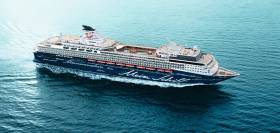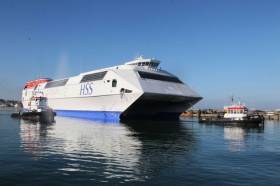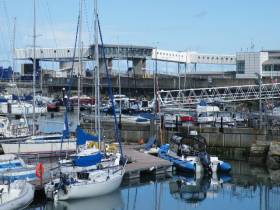Displaying items by tag: Dun Laoghaire Harbour
US Luxury Sail Assisted Flagship Bids Dun Laoghaire Farewell As Last Cruiseship of 2016
#FinalCaller – Five masts, each 221ft towered above Dun Laoghaire Harbour’s Carlisle Pier as US luxury operator, WindStar Cruises motor sail-assisted flagship Wind Surf made the last call of the season, writes Jehan Ashmore.
The 14,000 gross tonnage Wind Surf had made a cruise turn around in the south Dublin Bay harbour. With a 312 capacity, Wind Surf was among eight callers this year bringing around 10,000 tourists and crew to the harbour's hinterland and visitor attractions.
In fact, Wind Surf has been the most frequent visitor since Dun Laoghaire welcomed back cruiseships on a more concerted basis that began in 2011. The cruiseship business is the only commercial shipping sector since Stena Line withdrew their HSS fast-ferry service to Holyhead, Wales in 2014.
WindStars customers arrived at Carlisle Pier to board Wind Surf that departed yesterday evening, it was observed the departure involved a pilot cutter from Dublin Port to guide the vessel into the bay. While at the same time some of her self-furling computer operated sails were unveiled.
The cruise first port of call is an anchorage visit off Dunmore East today on the Waterford estuary. She then heads for Tresco, Scilly Isles, Brest, France, followed by a day at sea in the Bay of Biscay bound for Ferrol and Vigo in Spain, Leixoes in neighbouring Portugal and culminating in the capital, Lisbon. From thereon, Wind Surf returns to her programme of Mediterranean cruising.
According to DLHC a variety of cruise calls from vessels holding 100 to almost 3,000 passengers arrived from the newly refurbished Hebridean Sky to the larger newcomer, TUI Cruises Mein Schiff 1 that anchored offshore aswell as Celebrity Silhouette, which made an appearance last year.
Six out of the 8 cruise ships visiting this summer berthed alongside Carlisle Pier from where passengers had the short stroll to the town centre.
Welcoming visitors to the town were Dun Laoghaire County Council town ambassadors and volunteers from the DLR Volunteer centre that created a great atmosphere.
Carolyn Hanaphy of Dun Laoghaire Harbour today said “We await the planning decision from An Bord Pleanala about our proposed cruise berth, such that we can attract over 100,000 cruise passengers per year.”
The season for 2017 will see half the total of callers, when four calls are scheduled by two cruiseships. Again they will be made by repeat cruise clients, WindStar represented by their Wind Surf and Star Legend.
Dun Laoghaire Harbour: Lasers Linkspans to Liverpool Too!
#FerryLinks – The Laser Radial World Championships hosted in Dun Laoghaire Harbour, is where participants of the prestigious championships, had use of a rather unusual launch facility, a ferry-linkspan, writes Jehan Ashmore.
Numerous lined-up laser trailers took to the incline of the linkspan on St. Michaels Pier (east) last in commercial use by Stena Lynx III in serving Holyhead. As a ferry correspondent, it was an odd sight to observe, even five years after the small fast-ferry plied the Ireland-Wales link.
The absence of the larger HSS Stena Explorer fast-ferry last year (following closure in late 2014) marks the end of almost 190 years of continuous service to this year. The historic route dates to 1826. This summer work began to dismantle the former Stena HSS berth on St. Micheals Pier (west), including passenger gangway and related infrastructure, though the jetty remains (see; Scrapyard to Beatyard report).
Returning to the recent work to the ‘laser’ related linkspan, this has also included removal of the berth’s pontoon, to increase the length of St. Michaels Pier for commercial ships. However, Dun Laoghaire Harbour Company have this berth allocated for the restoration of a seasonal-only Wales ferry service, when this berth is available from 2017. Secondly, should an operator be successfully secured following an E-tender process.
If required, the linkspan can be adapted to suit the operator (if introducing conventional tonnage) as St. Micheals Pier, is the site of an original terminal completed in 1969. The facility was designed for first generation car-ferries, following a temporary terminal on the East Pier's jetty. This is where Dublin Bay Cruises excursion boat St. Bridget berths.
Over the decades, St. Michael’s double linkspans have asides the harbour’s most famous and familiar last route in operation to Holyhead, have included another second route. That been to Liverpool and in which the service ran until 1990. Predating the Merseyside link, other routes were to Heysham, Lancashire and later Fishguard in Pembrokeshire.
It was the Earl William, of Sealink British Ferries (in which Stena tookover) that operated the Dun Laoghaire-Liverpool (Bootle Docks) service. SBF took over, following B&I Line's closure in 1988 of the route out of Dublin Port. The service however, only lasted for just two years, as final sailings took place in early 1990.
As an avid ferry enthusiast and having taken a round-trip, it was odd to have a Dun Laoghaire ferry take a passage across Dublin Bay, in that the course set was straight towards Baily Lighthouse on Howth Peninsula and via the North Burford buoy. As distinct to the departure of Holyhead bound ferries that having rounding the East Pier Lighthouse headed for the South Burford buoy off Dalkey Island.
Asides, Earl William, a succession of conventional ferries and freight ferries, have berthed at St. Michaels Pier. The Holyhead’s routes largest and longest serving ferry, St. Columba, that became Stena’s Hibernia / Stena Adventurer exclusively berthed at Carlisle Pier. These ferries would arrive closely together into Dun Laoghaire at dawn, one from England, the other Wales.
Carlisle Pier, which was had a rail-connected terminal is where the older ‘mailboats’ berthed on both pier sides. On the east berth, is where in recent years, small cruiseships have called alongside, most recently, the impressive sail-assisted Wind Surf.
Currently, only large deep draft cruiseships anchor offshore, however there are controversial plans for a new cruise-berth jetty (awaiting An Bord Pleanala decision). The proposed €18m single-berth facility, if granted planning permission would almost occupy the centre of the harbour.
Against this backdrop is the already granted Dublin Port €30m two-berth cruise terminal.
#ProfitsSink - Dun Laoghaire Harbour will welcome tomorrow a mid-season cruise caller, this will be against the backdrop of losses by the port company last year, writes Jehan Ashmore.
Celebrity Silhouette of 122,400 gross tonnage, and a combined passenger and crew total of 4,000, is to make a return 'anchorage' visit off the south Dublin Bay harbour following a debut call in 2015. A proposed new cruise liner berth submitted by Dun Laoghaire Harbour Company is still awaiting a decision by an Bord Pleanala.
Accounts for the Dun Laoghaire Harbour Company reveal a €6.3 million loss reports The Times, after Stena Line officially confirmed that is was to withdraw HSS services ‘permanently’ from the port to Holyhead last year. Not to be confused Afloat adds with the final season of HSS Stena Explorer sailings that actually took place the previous year when the fast-ferry ceased in September 2014.
The company had previously said that it was focused on finding a new operator to continue the long history of ferry links between Dun Laoghaire and Britain.
In its latest annual report it said that while it still hoped to resume some ferry services to Holyhead, it was also looking at new uses for the St Michael’s Pier terminal building.
When Stena Line ceased to operate the route in February 2015 seven expressions of interest were received as previously reported on Afloat.ie.
Also reported on Afloat was the dismantling and removal of the former Stena HSS berth-linkspan and associated passenger gangway structure. Since that report, Afloat has learnt that the custom-built linkspan at St. Micheal’s Pier has been removed on site and not taken away by barge.
The process of removing HSS related port infrastructure are scheduled to take up to next month. DLHC added that harbour facilities will only become available for use by a potential new ferry operator but not until 2017.
Dun Laoghaire harbour and marina looks great in the summer sunshine but most of all this latest drone footage to promote a Global CoderDojo Conference in October reveals Dun Laoghaire's compact and very complete regatta site with the close proximity of hotels, conference centre, rail links and restaurants all within metres of Dun Laoghaire's waterfront yacht clubs and a five gold anchor marina opening out on to Dublin Bay. The next big sailing event for Dun Laoghaire is this month's KBC Laser Radial World Championships is at the Royal St. George YC where 350 competitors and 48 nations will attend.
#LuxuryMarket - Noble Caledonia's headquarters in London is close to the Irish Embassy in exclusive Belgravia, and the connection with this operator and our country was made when their newest cruiseship addition called for the first time to Dun Laoghaire Harbour today, writes Jehan Ashmore.
As previously reported on Afloat.ie, Hebridean Sky was re-launched by Noble Caledonia having been the Sea Explorer 1. In fact, the luxury small ship Hebridean Sky was completed in 1991, the same year Noble Caledonia was established. Not only was there a change of name but also the 114 guest capacity vessel is fresh from a Spring time multi-million refurbishment to upgrade both the technical and interior of this vessel serving in the high-end luxury small ship cruise market. The ‘Sky’s next port of call was to Portrush.
She joins a pair of sisterships that are more akin to private yachts and form part of a large yet small ship cruise fleet (including river cruising vessels) operated by Noble Caledonia. The trio of flagship sisters (out of an original order of eight vessels) were all built in the same ship yard in Italy at similar times. They share attributes that make them among the finest small ships in the world. A competitor for example, Hapag Lloyd’s Bremen last week visited Bere Island, Co. Kerry.
Hebridean Sky is also noted for been the first cruiseship to dock alongside Dun Laoghaire’s upgraded Carlisle Pier, which Afloat reported back in April. The works included installing new fenders to berth No. 2 so to improve berthing infrastructure for small cruise ships and repairs to the outer pier piles.
These works costing in the region of €1m investment also involved repairs to a storm damaged stretch of the upper tier of the East Pier. This important public amenity attracts locals and cruise visitors alike and boasts the largest footfall of any Irish pier.
The Dun Laoghaire Harbour Company have already welcomed the season’s debut caller, Mein Schiff 4 last month. Asides ‘Sky’s call a further six callers are scheduled, in which she is due back mid-August. Of these calls, just one remains of a much larger and deeper draft cruiseship, the debut in July of Celebrity Silhouette with a 2,886 passenger capacity and 1,525 crew.
The call to Dun Laoghaire of the giant 122,400 'Solstice' class ship operated by Celebrity Cruises is due to tidal restictions in Dublin Port that day. Otherwise the ship will make two calls to the capital this season.
Just before 6am this morning, the giant cruise liner Mein Schiff I sailed into Dublin Bay on overnight passage from Scotland. As soon as the ship dropped anchor in Scotsman's Bay on the Captial's south shore, small tender boats were lowered into the water from its port side and the ship began to disembark passengers to go ashore at Dun Laoghaire Harbour. A Dublin Port Pilot boat accompanied the ship to its anchorage. Today, in Dun Laoghaire town, a welcome party is set to greet the passengers. Read more: Dun Laoghaire visit of Mein Schiff.
At the same time this morning, the Magic Disney liner docked in Dublin Port.
Dun Laoghaire Harbour Welcomes Cruise Ship Mein Schiff 1
Dun Laoghaire Harbour welcomes the TUI Cruise “Mein Schiff 1” on her first visit to the town tomorrow.
The US$320 million TUI Cruise ship Mein Schiff 1 weighs over 76,000 tonnes, comes complete with a Japanese style aqua spa, three swimming pools and can host over half of its 1,870 guests for dinner in just one sitting.
The ship is on a 12 day cruise of Britain & Ireland with a stop off in Greenock (Glasgow) before her 12 hour stopover in Dun Laoghaire arriving at 07:00 Thursday 26th May. The ship will continue on to Holyhead leaving Dublin at 20:00 on route to Cork then Southampton before completing her journey in Bremerhaven Germany.
Mein Schiff 1 is the first of 8 cruise calls to Dun Laoghaire this summer welcoming almost 10,000 passengers and crew to the area.
Carolyn Hanaphy of Dun Laoghaire Harbour Company said today “We are thrilled to welcome this world class cruise ship here to our beautiful harbour. A local group of volunteers and local businesses are ready to welcome 3,000 guests and crew to the town along with a Welcome Concert outside the Pavilion at 14:00 on 26th“
#HSSforSale - Stena Line’s former Dun Laoghaire-Holyhead fast ferry, HSS Stena Explorer is up for sale again for around £4.5m - just months after it was sold as previously reported on Afloat.ie
The Stena Explorer, once one of the world’s fastest large ferries, was sold in October to Turkish firm Karadeniz Holding who were planning to convert it into a high-tech floating office.
It was taken from Holyhead to Turkey last year and as Afloat adds following the withdraw of the HSS craft from the route that closed in September 2014.
But now the ferry - that originally cost £65m and first came on the Holyhead to Dun Laoghaire route in 1996 - is available to buy again.
Its price has fallen somewhat since its unveiling 20 years ago and is now available for $6.5m, around £4.5m.
For more on the story, the Daily Post has a report here.
In addition to Afloat's report of a project to dismantle the Stena HSS berth in Dun Laoghaire Harbour.
Disused Stena HSS Berth to be Removed from Dun Laoghaire
#HSSberth – The disused Stena HSS berth at Dun Laoghaire Harbour is to be dismantled and removed in a process taking up to 10 weeks to complete, writes Jehan Ashmore.
Planning permission was granted to Stena by Dun Laoghaire-Rathdown County Council to dismantle berth No. 5 at St. Micheal’s Pier from where the final HSS Stena Explorer sailing to Holyhead took place in September 2014.
The operator having consolidated existing services on the Dublin Port route to the Welsh port that began in 1995.
Work at No. 5 berth is where the specialist docking infrastructure designed only for Stena HSS 1500 class fast-ferries, is to involve the removal of the linkspan, gangway and associated equipment.
A tug, MTS Valour is to begin towage of a barge from Stranraer, Scotland to Dun Laoghaire where the HSS related structures are to be loaded on board.
Coincidentally, Stranraer is also where Stena operated the HSS Stena Voyager in tandem with a pair of ferries on the Belfast route until switching Scottish ferryport to Cairnryan in 2011.
Also as part of the works in Dun Laoghaire (see Notice to Mariners No. 9) will be the removal of the pontoon at No 4 which is the adjacent berth on St. Micheals Pier. This berth-linkspan was last used by the smaller fast-ferry, Stena Lynx III until 2011.
Afloat.ie awaits a response from Dun Laoghaire Harbour Company to finally confirm proposals to restore seasonal-only ferry services to Holyhead, having begun a tendering process in February 2015.
Only in recent months saw the retail letting opportunity of the former ferry terminal and now the project to remove ferry-related infrastructure from the port.
#FrenchNavy - A pair of French Navy trainee vessels visited Dun Laoghaire Harbour while all the attention focused on the NATO flotilla to neighbouring Dublin Port last weekend, writes Jehan Ashmore.
It was a busy scene as hundreds of visitors flocked to the NATO six-strong flotilla on the Liffey beside the East-Link Bridge. In stark contrast across the bay in Dun Laoghaire, French Navy vessels Tigre and Jaguar were berthed without the attention that a NATO call can draw, largely due to media coverage.
Senior French naval ratings were welcomed from the two Leopard class vessels at a reception held in the Harbour Lodge of the Dun Laoghaire Harbour Company.
Each of the 335 tonnes vessels docked at berth No. 3 along St. Micheal’s Pier where the ‘former’ ferry terminal is available to let as previously reported on Afloat.
At this berth is also located the harbour’s only suitable ferry berth linkspan (see photo). The facility is to the left of the naval vessels but cannot be seen in the above photo.
On the adjacent side of St. Michaels Pier, is berth No. 4, where a linkspan (now redundent) was custom-built to handle the specialist berthing requirements of the HSS Stena Explorer. The fast-ferry was withdrawn from the Holyhead route following Stena’s closure of the service in 2014.




































































